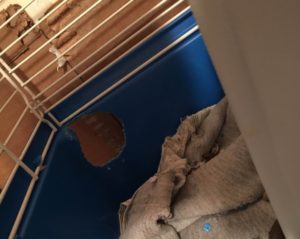 Rats can easily chew through plastic Rats can easily chew through plastic So, last month, I covered finding the right rat for you and choosing your new (or additional) companion. Now that you might have some idea of who your next furry friend(s) will be, you will need to think about the type of home that will be most welcoming for them! Please remember that, if you are getting a companion for an existing rat or rats, then you will need to maintain TWO cages for the time that you are working on introductions. Some introductions take no time at all and others can take months and/or not happen at all. Rats are individuals, just like people, and, similar to people, they don’t necessarily like/tolerate all other rats. I would venture out on a limb and say that most rats, with enough time and patience, will eventually be able to cohabitate. There are always exceptions to this generalization though! On to CAGES!
I will say, from personal experience, that rats can and will get their back feet caught and potentially stuck/trapped in this particular size of wire which may lead to severe injury (think broken ankle). I prefer cages that are all metal because they are chew proof and you never know if your new companion is a chewer until you wake up late for work and realize that someone chewed out of their cage and is on a walk-about in your home somewhere! (Been there, done that!) Plastic pans are fine but only if you either know your rat won’t chew out of it OR if the wire cage sits inside the cage. Martin’s Cages are a fantastic example of a wire cage that sits inside the pan and their shelves are made from ½”x½” wire mesh which is more tolerable for little rattie feet. I would still suggest covering the shelves and ladders with fleece using tiny binder clips but, in my experience, rats do fine in their cages. I would also suggest their powder coated cages over the galvanized cages because the galvanized cages will eventually rust and look terrible. 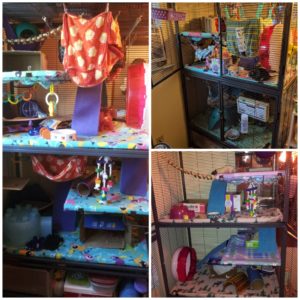 Examples of well stocked Critter Nation Cages Examples of well stocked Critter Nation Cages At the time of this article, the cages that I currently use and highly recommend are the Critter Nations by Midwest Homes for Pets. They claim to be “The World’s Best Small Animal Habitats” and I would, wholeheartedly, second that claim with one caveat. The pans and shelves that come standard with the cage do not keep the bedding in the cage and get chewed very quickly. I replace all my pans with Bass Pans. Originally, I ordered the galvanized version because that was the only option available but, if you know you are going to keep having rats for quite some time, please save yourself the trouble and get their stainless steel version! For the same issue as the wire cages, galvanized pans will discolor, rust, and become pretty gross over many years of constant use. I am currently in the process of upgrading all of my pans to the stainless steel version. Critter Nation cages are amazing! The single level version is an excellent choice for up to 6 rats. The doors open fully and are readily removable to make weekly cleaning relatively quick and easy. They offer a double critter nation which is even better if you have the space and there are add-on units available if the sky is your limit. At the moment, I use a triple critter nation which is a double plus one add-on unit. I’m short so I need a step stool to care for the very top of the cage so I wouldn’t really suggest going higher than that. If you really do not have the space for a Critter Nation, then I would suggest getting a Rat Manor which is moderately smaller but still good for 2-3 rats. I prefer not using any of the shelves that come with it so I can get creative on the inside but the mesh shelves are fine for the rats.
After getting the cage set up in the preferred area of your home, you’ll need to take some time to furnish their home much in the same way that you would furnish your own home. The basic accessories required are a water dispenser, food dispenser, and house to sleep in. I strongly recommend getting and using GLASS water bottles. They are easier to clean and sanitize and can’t be chewed. The water should be used quickly and changed regularly so an 8oz bottle for 2 rats is fine. I would suggest having a few water bottles on hand to use when you need to go away for a weekend or on really warm days when they might go through more water than normal. As for food dispensers, I use and prefer the Snap’y Fit bowls from Midwest Homes for Pets who also manufactures the Critter Nations recommended earlier. I use the 20oz bowls but my groups are typically 4-6 rats so if you just have 2-3, the 10oz bowl will likely work for you. I like these because they can’t be chewed and the bowl easily comes off for cleaning. Food tends to go where the rats want to “hide” it though so some people have had great success hanging “pom poms” over the food to help “protect” it so the rats don’t feel the need to hide it in the corner under all the bedding! Darling Rats is a great place to get these pom pom food bowl covers. As for houses, I use and recommend the Large Space Pod by Lixit. These are great because they can go on the floor or be hung from the top of a cage and the rats REALLY seem to like these. Yes, the plastic does get chewed so you’ll need to get a few but they are relatively affordable and easy to clean and use. Additional things to consider for your rats’ habitat are hammocks, chew toys, shelves and ledges, and things that might keep them busy and entertained. If you have females, I would also offer them a LARGE wheel (12”+) just in case they like it. Some boys will also use wheels but it generally seems to be more of a female tendency whereas males seem to use it for sleeping and pooping. 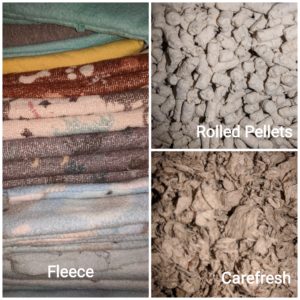 Some safe bedding and litter options Some safe bedding and litter options And…while on the subject of pooping, let me take a moment to cover the bedding options and cleaning of this new space for your rats. The choice of bedding is mainly a personal preference. AVOID pine and cedar as the chemicals that make them smell so nice may also cause damage to a rats’ fragile respiratory system. Most people, myself included, will choose to use a recycled paper bedding like CareFresh or Yesterday’s News. Others prefer lining the cage surfaces with fleece or felt because it is soft, absorbent, and you can just cut it to shape with no fraying and use binder clips to secure it. I use the paper bedding option and clean cages once a week. I’ve tried the fleece/felt but I felt like the cages needed more regular maintenance because the fabrics don’t do much to control the smell. Others still will employ a combination of both by lining the cage with material and using a litter box with paper bedding. Rats are VERY intelligent and associative so potty training, in theory, is definitely an option though, in my experience, females are much easier to potty train than males and I typically choose to keep males. How often you actually clean your cages will also depend on your personal set up. At the very least, the cages will need to be cleaned once a week. If you have a lot of rats, or you’re using fabric and you think it’s stinky, or for whatever other reason, you may end up cleaning the cage out more often. I only have time for a weekly cage clean so I choose to go with the pelleted recycled paper bedding.
I prefer to use a Vinegar Recipe with some essential oil to help with the smells. I feel it is safer for the animals and it smells much nicer than bleach. There are cage cleaning solutions out there like Nature’s Miracle, which I have used historically as well and would also use and recommend if you prefer a pre-made solution. The most important aspect is that the whole cage will need to be cleaned about once a week.
To wrap things up, we’ve established that the bigger the cage the better! We’ve also reviewed the type of cage and placement of the cage within your home. We discussed the basic cage accessories as well as the better cage accessories and we’ve reviewed the general aspects of cleaning your cage. Companion rats are caged-animals and, as such, they are going to spend A LOT of time in their cages. It is your responsibility, as the guardian they rely on, to provide them with a clean space and stuff to do and play with in that space. Feel free to get creative! Look online at what other people are trying out in their spaces, some examples include: a digging box, treat pinatas, and MORE!!! A lot of the DIY rat toys are made from recycling stuff that you already have lying around your house. Start saving those toilet paper rolls, packing paper, and plastic bottles and see what you can come up with! There are a ton of things that you can do with your pet rats to keep them happy and healthy!
0 Comments
|
AuthorDiane Weikal, founder of Rattie Ratz, wrote this monthly blog in celebration of our 20th anniversary of rescuing rats! Archives
December 2018
Categories |
|
© Copyright 2024 Rattie Ratz
California Registered Public Benefit Org United States Tax Exempt Organization 501(c)(3) IRS FEIN #94-3400283 |
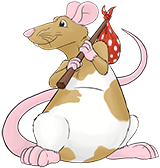
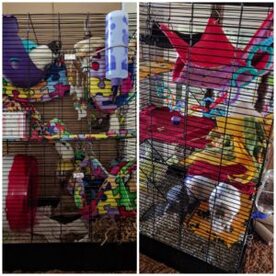
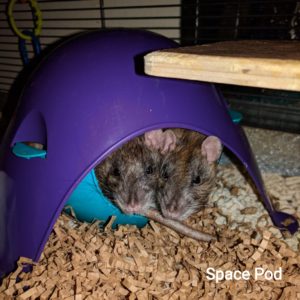
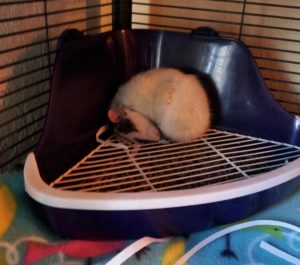
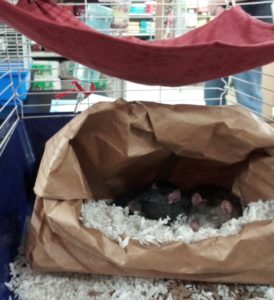
 RSS Feed
RSS Feed